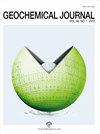Watershed analysis for geochemical mapping in Japan based on a hydrologic model: The concentrations of 53 elements and the dominant lithology in a drainage basin
Atsuyuki Ohta, N. Imai, Takashi Okai, M. Manaka, Ran Kubota, A. Nakamura, Yoshiko Tachibana
求助PDF
{"title":"Watershed analysis for geochemical mapping in Japan based on a hydrologic model: The concentrations of 53 elements and the dominant lithology in a drainage basin","authors":"Atsuyuki Ohta, N. Imai, Takashi Okai, M. Manaka, Ran Kubota, A. Nakamura, Yoshiko Tachibana","doi":"10.2343/geochemj.2.0618","DOIUrl":null,"url":null,"abstract":"Copyright © 2021 by The Geochemical Society of Japan. cross-boundary and sub-continental geochemical mapping projects have been actively pursued, with the main objective of environmental assessment (Bølviken et al., 1986; De Vos et al., 2006; Reimann et al., 1998; Salminen et al., 2005). In Japan, the Geological Survey of Japan, the National Institute of Advanced Industrial Science and Technology (AIST), has created country-scale land and sea geochemical maps using 3,024 stream sediment samples and 4,905 marine sediment samples, for 53 elements (Imai et al., 2004, 2010). Japanese geochemical mapping is designed for environmental assessment in mining areas, large-scale urban regions, and coastal sea zones, and for the investigation of migration processes of materials from the land to the sea. Sampling location, sample photographs, color maps, and elemental concentrations are available in the online database (https://gbank.gsj.jp/ geochemmap/). Furthermore, we are also in the process of creating a regional spatial distribution map of Sr isotopic ratios using stream sediments, collected for JapaWatershed analysis for geochemical mapping in Japan based on a hydrologic model: The concentrations of 53 elements and the dominant lithology in a drainage basin","PeriodicalId":12682,"journal":{"name":"Geochemical Journal","volume":"88 1","pages":""},"PeriodicalIF":1.0000,"publicationDate":"2021-01-01","publicationTypes":"Journal Article","fieldsOfStudy":null,"isOpenAccess":false,"openAccessPdf":"","citationCount":"0","resultStr":null,"platform":"Semanticscholar","paperid":null,"PeriodicalName":"Geochemical Journal","FirstCategoryId":"89","ListUrlMain":"https://doi.org/10.2343/geochemj.2.0618","RegionNum":4,"RegionCategory":"地球科学","ArticlePicture":[],"TitleCN":null,"AbstractTextCN":null,"PMCID":null,"EPubDate":"","PubModel":"","JCR":"Q3","JCRName":"GEOCHEMISTRY & GEOPHYSICS","Score":null,"Total":0}
引用次数: 0
引用
批量引用
Abstract
Copyright © 2021 by The Geochemical Society of Japan. cross-boundary and sub-continental geochemical mapping projects have been actively pursued, with the main objective of environmental assessment (Bølviken et al., 1986; De Vos et al., 2006; Reimann et al., 1998; Salminen et al., 2005). In Japan, the Geological Survey of Japan, the National Institute of Advanced Industrial Science and Technology (AIST), has created country-scale land and sea geochemical maps using 3,024 stream sediment samples and 4,905 marine sediment samples, for 53 elements (Imai et al., 2004, 2010). Japanese geochemical mapping is designed for environmental assessment in mining areas, large-scale urban regions, and coastal sea zones, and for the investigation of migration processes of materials from the land to the sea. Sampling location, sample photographs, color maps, and elemental concentrations are available in the online database (https://gbank.gsj.jp/ geochemmap/). Furthermore, we are also in the process of creating a regional spatial distribution map of Sr isotopic ratios using stream sediments, collected for JapaWatershed analysis for geochemical mapping in Japan based on a hydrologic model: The concentrations of 53 elements and the dominant lithology in a drainage basin
基于水文模型的日本流域地球化学填图分析:流域53种元素的浓度和优势岩性
日本地球化学学会版权所有©2021。积极开展跨界和次大陆地球化学制图项目,主要目的是进行环境评价(Bølviken等人,1986年;De Vos et al., 2006;Reimann et al., 1998;Salminen et al., 2005)。在日本,日本地质调查局、国家先进工业科学技术研究所(AIST)利用3024个水系沉积物样本和4905个海洋沉积物样本,绘制了53种元素的国家尺度陆地和海洋地球化学地图(Imai et al., 2004,2010)。日本的地球化学填图主要用于矿区、大型城市地区和沿海海域的环境评价,以及研究物质从陆地向海洋的迁移过程。采样地点、样品照片、彩色地图和元素浓度可在在线数据库(https://gbank.gsj.jp/ geochemmap/)中获得。此外,我们还在利用溪流沉积物创建Sr同位素比率的区域空间分布图,这些沉积物是为日本流域分析收集的,用于基于水文模型的日本地球化学制图:流域中53种元素的浓度和主要岩性
本文章由计算机程序翻译,如有差异,请以英文原文为准。


